Tokyo, Japan (July 19, 2017) – Dentsu Public Relations Inc. announced the results of the 2017 Corporate Attractiveness Survey conducted by the Corporate Communication Strategic Studies Institute, an internal think-tank. The survey offers an analysis of aspects the Japanese public considers attractive in companies and how those features are communicated to them. The survey was conducted in March this year, covering 10,000 respondents aged 20-69 from across Japan.
The survey included 150 companies in 10 industries and analyzed their attractiveness according to the three elements of the Corporate Attractiveness Model: Personal Attractiveness, Corporate Attractiveness and Product Attractiveness.
The survey was first conducted in March 2016, and will continue to be performed annually.
This press release covers some parts of this year’s results, namely industry ranking by attractiveness, ranking of attractiveness attributes, and year-on-year changes in attractiveness scores.
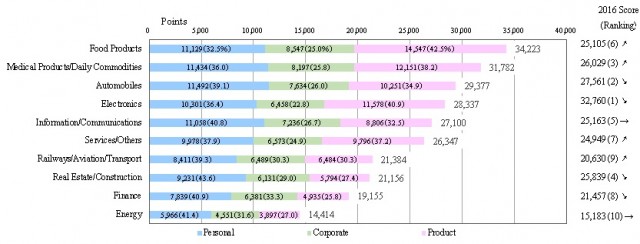
Graph 1
2017 Industry Attractiveness Ranking
1. Food Products industry rated most attractive
The industry ranking is based on the total number of items the 10,000 respondents felt were attractive within each industry (attractiveness points). This year, the Food Products industry was ranked the most attractive with 34,223 attractiveness points. The Food Products industry score improved markedly from the previous year (25,105 points; ranked sixth) and surpassed last year’s highest score of 32,760 (Electronics) by 1,463 points. (See Graph 1)
Of the three elements of the Attractiveness Model, the Food Products industry improved most in Product Attractiveness, especially in terms of providing “good after-sales service and response to inquiries,” an item that improved by 178% (314 points -> 559 points; up 245 points) from the previous year. Open questions also produced such responses as “I was satisfied with the company’s response when I was unhappy with their product” (female, 30s), indicating that how companies respond to problems can strongly affect the results.
Another item that improved significantly for the Food Products industry was in the number of respondents who felt the companies provided “innovative or advanced products and services,” up 167.8% from last year (404 points -> 678 points). Open questions produced answers such as “I feel the company is always innovating and developing new products” (male, 60s), “the new products are original, fun, and enjoyable. I feel they are working hard to make their customers happy” (male, 30s), “their products are both healthy and delicious” (female, 20s), “they offer food products designed with health in mind, so I feel they are trying to help resolve issues such as lifestyle diseases” (female, 20s), revealing that respondents appreciate taking current trends and needs into account in product development and other efforts. It is likely that the introduction of the “Foods with Function Claims” system in April 2015 has also had a positive impact, as it has prompted more companies to develop and introduce healthy products.
On the other hand, scores for the Electronics industry, ranked first a year ago and fourth this year, fell across the board. The largest drop was in the Corporate Attractiveness category, with attractiveness scores of growth strategies as well as investment/financial strategies dropping over 20%. As a result, the attractiveness of the entire industry declined sharply.
2. Importance of Personal Attractiveness grows, up 6% from previous year
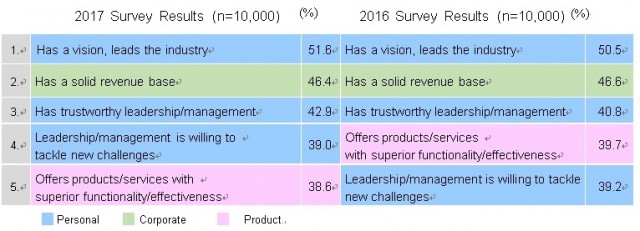
Graph 2
2017 Ranking of attractiveness factors
A ranking of the attributes that contributes to company attractiveness shows an unchanged top three from the previous year, with 51.6% of respondents choosing “having a vision and leading the industry” as the most attractive feature for the second consecutive year.
The only change in the top five from the previous year was that fourth and fifth places were reversed. Three of the top five (ranked first, third and fourth) factors are Personal Attractiveness attributes. (See Graph 2)
Moreover, the combined attractiveness score across all industries grew by 3.5% from last year. (See Graph 3.)
A closer look shows that the total Personal Attractiveness score increased by 6%, or 5,459 points, while Corporate Attractiveness increased by 2.9% (1,938 points) and Product Attractiveness by 1.4% (1,202 points).
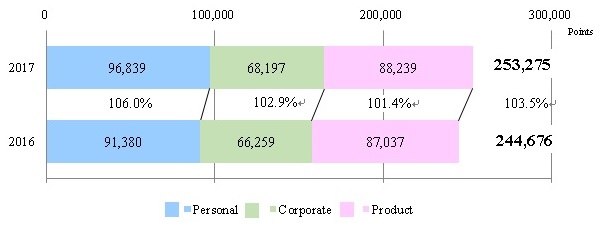
Graph 3
Year-on-year change in combined attractiveness score across all industries
The results indicate that respondents focus mostly on Personal Attractiveness when evaluating a company; this tendency has grown stronger from the previous survey. Among the 18 most attractive companies, Product Attractiveness is the most highly ranked element, while Personal Attractiveness improved the most from the previous year (47.1%). This indicates the importance of Personal Attractiveness is on the rise. (See Graphs 4 and 5)
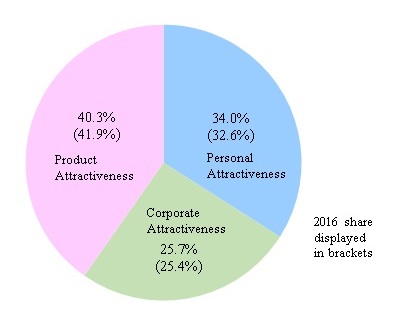
Graph 4
Relative importance of attractiveness elements for 18 most attractive companies
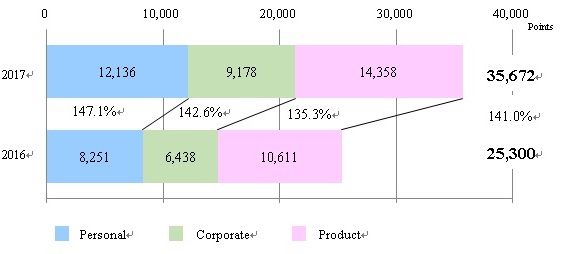
Graph 5
Year-on-year change in attractiveness element scores for 18 most attractive companies
■Survey Outline
Respondents: Men and women aged 20-69 from across Japan; 1,000 respondents per industry, 10,000 respondents total
Survey Method: Online survey
Survey Period: March 24 – March 29, 2017
Surveyed Companies: 150 companies in 10 industries
Survey Topic: Attractive industries, attractive companies, attractive elements etc.
Surveying Organization: Corporate Communication Strategic Studies Institute (Dentsu Public Relations Inc.)
*Please reprint or quote the survey at your own responsibility and clearly indicate that the survey and analysis were performed by the Corporate Communication Strategic Studies Institute/Dentsu Public Relations Inc.
The Attractiveness Marketing Model
The Attractiveness Marketing Model is a new analysis model that uses the three elements of Personal Attractiveness, Corporate Attractiveness and Product Attractiveness to verify what corporate activities and aspects members of the general public and investors consider attractive.
The model was developed by the Corporate Communication Strategic Studies Institute in 2016.
Definitions of the Three Elements of Attractiveness
- Personal Attractiveness: Leadership, workplace culture, and ability to respond to social issues; attractiveness felt through the individuals who form a company and attractiveness of the company entity felt through its business activities.
- Corporate Attractiveness: Growth strategy, stability, mid- and long-term profitability, and corporate governance and risk management ability; attractiveness felt through strong financial performance and the structures and efforts that enable it.
- Product Attractiveness: Value for money, safety, quality of after-sales service, responsiveness to complaints, uniqueness and innovativeness; attractiveness felt through the products and services a company provides.
Dentsu Public Relations Inc.
Since its founding in 1961, Dentsu Public Relations Inc. has been a strategic partner providing reputation management solutions to a wide range of domestic and foreign companies, governments and organizations.
Its 271 employees support clients by enhancing their ability to communicate with the wider society through data analysis, insight-driven content design and optimization of information distribution. Dentsu Public Relations Inc. won The Holmes Report’s Japan Consultancy of the Year award in both 2009 and 2015.
Corporate Communication Strategic Studies Institute (C.S.I.)
A research institute headed by Kentaro Miura, established in December 2013 within Dentsu Public Relations Inc. The institute conducts surveys, analysis and research into corporate communication strategies and frameworks in collaboration with management and communication specialists including university professors and researchers.
